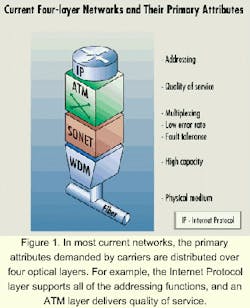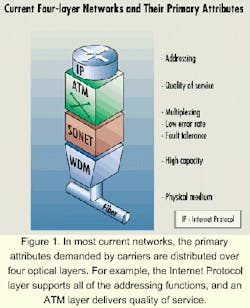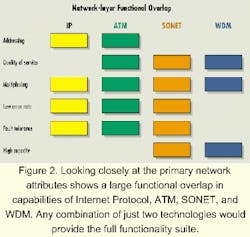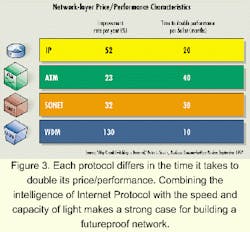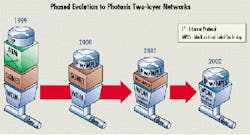Business impact of transparent optical switching
IP and optical layers will define future Internet expansion and lead us into the long-promised all-optical-network architecture.
Luc Ceuppens, John Drake, and Jonathan Lang
Calient Networks
With WDM and Internet Protocol (IP) as the dominant technologies in current networks, it is widely expected that the convergence of IP and optical layers will be the defining theme in the next Internet expansion phase. At the optical layer, WDM offers enormous bandwidth and increasingly sophisticated reconfiguration capabilities. At the services layer, IP offers connectivity and service capabilities to end systems. As capabilities grow rapidly in both technologies, it becomes appealing to bypass intermediate-layer technologies such as SONET/SDH and ATM and move valuable intermediate-layer functions to either the optical or IP layer.
The emergence of the IP/Multiprotocol Label Switching (MPLS) framework as a common control plane for data and optical layers is an early, but definitive, trend indicator. Furthermore, optical-switching technology is rapidly evolving and will ultimately lead to the long-promised all-optical or photonic network, which naturally succeeds the current DWDM networks.
During the last two years, operational costs have replaced capital costs as the primary network design parameter. While capital costs are still important when designing and building networks, the escalating operational costs are responsible for keeping carriers up at night. Recent advances in optical-fiber and optical transport systems have dramatically lowered the unit cost of moving a gigabit of traffic over a mile. Knowing that it will cost less to build the network, the next logical step is to try to lower operational costs.In addition to known operational parameters such as workflow automation, business support systems, flow-though provisioning capabilities, real-estate management, and right-of-way acquisition plans, network design significantly impacts operational costs. Beyond design parameters like regenerator and amplifier spacing, optical line speeds, channel count, and power- and cooling-plant sizing, the technological innovation curve or rate of improvement of a technology will determine the network operations cost curve.
With that in mind, we can look at some key attributes of carrier networks (see Figure 1) and analyze which technologies provide these attributes to identify the best combination of technologies to support a continuous reduction in operational costs. As shown in Figure 1, current networks distribute the support of the key attributes over four layers. In a typical network, IP supports all of the addressing; ATM delivers the quality of service; SONET provides multiplexing, low error rates, and fault tolerance; and the combination of DWDM and fiber type provides the large capacity.A closer look at these technologies reveals a large functional overlap of their capabilities (see Figure 2). Three technologies can perform at least four network functions, and a combination of just two technologies would provide you with the full functionality suite.
The technological innovation curve and the rate of improvement of a technology are important. To aggressively and continuously lower the operational costs of a network, technologies that have the steepest improvement curve are first to be combined. WDM doubles its price/performance every 10 months (see Figure 3), while IP requires about twice that time to double performance for the same dollar. SONET and ATM take three and four times as long, respectively. Combining the intelligence of IP with the speed and capacity of light is undoubtedly the only viable strategy for building futureproof networks.
Service providers have been busy multiplying the raw bandwidth capacity of their networks with DWDM technology, continuously increasing the number of channels on a single fiber. While that addresses the capacity problem, it does little to make the networks smarter.
Until now, the best-known approach to implementing two-layer networks was the "smart router, dumb optics" approach, advocated by major router vendors. This model claims optics are good at transport and electronics are good at switching/routing, so networks should consist of big, fat, and dumb pipes (point-to-point DWDM links) interconnected with intelligent routers. But the fact that DWDM improves at twice the speed of IP (see Figure 3) already created a gap between the aggregate trunk speeds that routers can handle and the speed at which fiber-optic networks currently run.
With the ever-increasing amount of traffic the networks need to handle, it will take the pace of photonic innovation to continue to meet market demand. That poses the question of whether routers should continue to operate at the core of the backbone or whether they should migrate to the service layer and become feeders into a backbone that exploits photonics rather than electronics through the use of photonic switches. Photonic switches, positioned at the major junction points of a network, switch information-carrying beams of light from one fiber to another. There is agreement that the next big revolution in optical networking will occur in the form of photonic-switching equipment.The optical-networking revolution will lead to two-layer networks that concentrate intelligence for resource management in the service layer (see Figure 4), with optical resource management provided through a control plane that is shared between the service layer and photonic transport layer. That will create a network architecture that delivers managed multigigabit bandwidth and provides reliable, wavelength-level, traffic-engineered network interfaces to the service platforms.
Service platforms include high-capacity IP routers, ATM switches and SONET add/drop multiplexers (ADMs). The service layer delivers services to users in various forms, relying entirely on the transport layer for the delivery of multigigabit bandwidth where and when it is needed. SONET transport gives way to photonic transport. Bandwidth is not provisioned at time-division multiplexing (TDM) granularities but at wavelength granularity.
This architecture leverages the strengths of both IP and optical technology-using the vast amount of research that has been done in network control and management in IP as well as the huge bandwidth available through WDM and photonic switching.
That is the scope of the Multiprotocol Lambda Switching (MPlS) protocol suite currently being developed within the Internet Engineering Task Force (IETF). MPlS will combine existing control plane techniques with the point-and-click provisioning capabilities of photonic switches to set up optical trails and distribute optical transport network topology state information. The MPlS control plane will support various traffic-engineering functions and enable a variety of protection and restoration capabilities, while simplifying the integration of photonic switches and label-switching routers.
The evolution to photonic networking will occur in three major phases (see Figure 5). Currently underway, the first phase involves the deployment of MPLS to provide packet transport with a quality-of-service capability similar to ATM. MPLS-enabled routers, often called label-switch routers (LSRs), are commercially available and already deployed by several network providers.The second phase will move toward optical restoration under the control of MPLS. A thin SONET layer will remain, primarily to provide framing, network management, and performance monitoring. SONET will begin its migration toward the service interface, which will play a major role in grooming traffic and packing it into very-high-capacity ports. However, the actual switching and traffic engineering will be done at the wavelength level.
In the third and final phase, all-optical performance monitoring, error detection, fault isolation, and restoration will move to the photonic layer. This phase could also see a movement away from today's transport-network focus on traffic grooming to a focus on wavelength flexibility. Studies at research labs and universities show that rapid, per-flow wavelength reconfiguration can provide significant performance improvements as compared to static path allocations where client access rates are comparable to the wavelength bit rates. These findings promote a transport network model with a very high channel count and TDM line speeds adapted to the application flows, such as 960 channels at 1 Gbit/sec. Today's DWDM technologies focus solely on very high channel speeds such as 96 channels at 10 Gbits/sec that require service providers to groom multiple applications into one high-speed TDM channel.
Deployment of photonic switches will also happen in phases. The first phase will involve the deployment of photonic crossconnects. Since total throughput of photonic crossconnects is an order of magnitude greater than their electronic counterparts, they will initially be configured as fiber switches that realign large chunks of bandwidth.
Fiber switching is the crossconnection of fibers (connected to the switch ports) without regard to the attributes of the optical signals being transported. As building blocks for photonic networks, photonic crossconnects will perform the following:
- Connection and bandwidth management, which will provision connections at the optical-channel level and provide wavelength add/drop functions, etc.
- Grooming, which will more efficiently use network and switch resources. The ability to carry and route a group of sub-rate constituents with common source and destination nodes on a single wavelength allows service providers to generate more revenue per switch port. In the event of a failure, only one wavelength needs to be rerouted instead of each individual constituent, enabling faster service restoration.
- Protection and restoration at the fiber and wavelength level. Since photonic switches switch photons (light beams), they naturally support routing and restoration at the physical fiber and optical wavelength levels.
- The ability to handle local and network traffic irrespective of bit rate or protocol, and provide switching, interconnection, protection and restoration at the fiber and wavelength level, through the use of industry-standard interfaces.
Beyond basic crossconnects lies the prospect of "smart" photonic switches performing dynamic switching with the speed and control of today's voice switches. That will make the networks more responsive to frequent shifts in traffic flow across the Internet. The embedded intelligence will allow switches to discover and monitor other switches in the network. It will also communicate with routers and other edge devices to set up and tear down optical connections on demand.
Within a matter of seconds, the ingress photonic switch will compute and establish the optimal path through the network based on a command from a network-management system or by acting on an industry-standard control plane protocol from neighboring routers, ATM switches, or SONET multiplexers. This capability, combined with per-flow wavelength assignment, will transform existing data networks into something that closely resembles the reliability and instant provisioning capabilities of today's telephone network.
The biggest controversy surrounding photonic networks is the degree to which the combination of DWDM and photonic switching is a substitute for SONET in the transport networks. Again, we must consider the service layer and transport layers separately. In high-speed transport networks, the promise of DWDM and photonic switching goes beyond having better economics than pure SONET solutions.
Photonic switches eliminate the current requirement to convert data to an electronic format prior to switching, resulting in significant reductions in capital cost since it removes the need for massive amounts of electronic switching gear at junction points along the backbone. Besides the economics, few find it practical to extend pure SONET solutions to speeds above OC-192 (10 Gbits/sec). Considering the ever-growing flow of traffic, service providers will soon require backbones capable of handling hundreds of terabits per second. DWDM, combined with transparent photonic switching, will be the only viable alternative to build this infrastructure.
At the service interface, however, some measure of optical-to-electronic conversion will be required. These optoelectronic boundaries will primarily consist of transponders, which enable systems not designed for tightly controlled WDM environments to still operate in such environments.Figure 5. The new photonic networks will evolve in three major phases: the deployment of Multiprotocol Label Switching (MPLS) to provide packet transport with ATM-like quality of service; a move toward optical restoration under the control of MPLS; and the migration of optical performance monitoring, error detection, fault isolation, and restoration to the photonic layer.
Most remaining SONET advantages pertain to manageability and survivability of optical networks. Current performance monitoring in optical networks requires termination of a channel, or wavelength, at an optical-electrical-optical (O-E-O) conversion point to read specific bytes in the overhead of the SONET frame. Since that results in higher cost, the optimal solution will implement the absolute minimum amount of optoelectronics required to ensure the desired optical signal quality and performance monitoring.
Concurrently, this solution must support easy migration to optical performance monitoring once the technological limitations are removed. Today, interfaces into the WDM systems are SONET-like. The challenge is to determine how SONET-like the interfaces in DWDM systems will remain. The bit rates will be common to the SONET rates and have basic SONET framing and, most likely, multiplexing. Functions that will need to be supported by this lightweight SONET include, at a minimum, A1, A2, B1, J0, and J1 byte monitoring and insertion and automatic protection switching using the K1/K2 bytes.
Photonic switches can be complementary to an existing SONET infrastructure since both technologies can coexist to maximize service revenue. Initially, the existing SONET infrastructure will continue to use one or more wavelengths in the optical spectrum, with the remaining wavelengths utilized for the new photonic network. In the short-term, the transparent optical switch fabric of the photonic switches can be surrounded with electronic-based line cards and interfaces plugged into the system as needed. As the capabilities of photonic switches expand and carriers grow more familiar with managing networks at the photonic level, use of these adapter cards can be reduced and even eliminated. At that point, SONET will become a service interface into the photonic network.
Photonic switching is the next logical step in a long history of switching technology that began with manual "plug board" operators and evolved to mechanical crossbar and digital switching. Photonic switching will enable transparent photonic networks that will greatly simplify the architecture of the network and network nodes by establishing end-to-end optical paths. Now that the basic components are available to build these networks, the most important innovations will come from incorporating the intelligence that enables all the network elements-routers, ATM switches, DWDM transmission systems, and photonic switches-to work together. This new, intelligent photonic network will allow service providers to provision high bandwidth in seconds.
As the capabilities of the optical layer grow, valuable functions such as traffic engineering, load management, performance management, and rapid restoration are gradually migrating to the photonic transport network. MPlS broadens the scope of MPLS and enables optical-network equipment and routers to speak the same language.
There are several synergies between LSRs and photonic switches and between a label-switched path (LSP) and an optical trail. Analogous to switching labels in an LSR, a photonic switch switches wavelengths from an input to output port. Establishing an LSP involves configuring each intermediate LSR to map a particular input label and port to an output label and port. Similarly, the process of establishing an optical path involves configuring each intermediate photonic switch to map a particular input lambda and port to an output lambda and port.
As in LSRs, photonic switches need routing protocols such as open shortest path first and intermediate system to intermediate system, to exchange link-state topology and other optical resource availability information for path computation. They also need signaling protocols such as resource reservation protocol and label distribution protocol to automate the path establishment process.
Beyond simple advertising and establishment of optical paths through the network, MPlS includes performance information about the network. The service equipment at the edges of the photonic network will use this information to dynamically manage the wavelengths available in the photonic layer. This intelligence, combined with per-flow wavelength assignment, will give the Internet the same capabilities as the public-switched telephone network but using wavelengths rather than TDM time slots as the unit of transport.
Several challenges still lie between today's networks and all-photonic networks. Among the obstacles to true optical transparency are wavelength conversion, all-optical regeneration, and optical performance monitoring. The premise of photonic networks requires the availability of tools to measure and control the smallest granular component of such networks-the wavelength channel. These functions include monitoring amplifiers and switches at add/drop sites, deployment and commissioning of DWDM routes, and restoration and protection of networks. That must be accomplished with speed and accuracy, implying that performance measurements have to be done while keeping the channel in optical format.
As photonic networks mature, it will be necessary to generate a more detailed picture of channel "health" in a manner that can be communicated to the network control entities as well as between other network elements. Detailed performance monitoring at the "digital level" will be performed at the service interfaces.
Protection switching is another issue raised as a key impediment to both transparent optical networks and DWDM networks. This problem appears to have less to do with DWDM than the use of DWDM in conjunction with SONET. A clear example of where optical protection is not advantageous is when DWDM is applied to overlaid SONET bidirectional line-switched ring or unidirectional path-switched ring configurations to reduce fiber consumption. The SONET layer already protects all the traffic carried by the optical layer (assuming that the physical topology of the optical layer preserves the diverse routing offered by the SONET ring), so any optical protection measure represents unnecessary duplication, a squandering of network capacity, and in some cases, slower-than-SONET response.
Where the optical layer bears point-to-point links such as IP or ATM links that potentially allow prompt traffic rerouting, optical protection provides benefits. In a transparent environment, most optical connections would shift to the backup fiber in 25 msec or less. Since photonic switches are complementary to the existing SONET infrastructure, the logical solution is to provide separate wavelength overlays for the two categories of traffic. Overlaid SONET rings can be supported by unprotected wavelengths, while a second wavelength overlay with optical protection supports point-to-point channels. This approach facilitates operational management. An overlay network either does or does not exhibit optical protection, and both overlays can be provisioned through the same photonic switch. Furthermore, unwanted interaction of client-layer and optical-layer protection mechanisms is eliminated.
Photonic networking offers the opportunity to compress protocol layers, drop intermediary technologies, and eliminate functional overlap. With a dynamic, intelligent, scalable, and transparent photonic network providing rapid provisioning and fast restoration of multigigabit services, service providers can scale their networks to meet even the steepest increases in bandwidth demand.
Luc Ceuppens is senior director of product management, John Drake is chief architect, and Jonathan Lang is senior systems engineer at Calient Networks (San Jose, CA).
